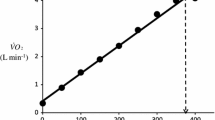Abstract
Oxygen consumption of the left ventricle (MVO 2) was evaluated theoretically under the condition that the ventricle pumps a constant stroke volume against a constant arterial pressure, hence producing a constant external mechanical stroke work, with a widely varied contractility.MVO 2 was calculated by an empirical equation which had been inferred previously. Theoretical results indicated that the ventricle has a contractility at whichMVO 2 is minimal in spite of constant external work and therefore the mechanical efficiency as a pump is maximal. Such a contractility can be considered to be optimal from a standpoint of metabolic economy. The optimal contractility fell within the physiological range of contractility which had been observed experimentally. The result suggests a possibility that the contractility of a normal heart might be physiologically adapted to such an optimal level.
Similar content being viewed by others
Literature
Bishop, V. S., D. F. Peterson and L. D. Horwitz. 1976. “Factors Influencing Cardiac Performance”. InInternational Review of Physiology, Vol. 9, Cardiovascular Physiology II (Eds. A. C. Guyton and A. W. Cowley), pp. 239–273. Baltimore: University Park Press.
Braunwald, E. and P. R. Maroko. 1974. “The Reduction of Infarct Size—an Idea whose Time (for Testing) has Come.”Circulation,50, 206–209.
Coleman, H. N., E. H. Sonnenblick and E. Braunwald. 1969. “Myocardial Oxygen Consumption Associated with External Work. The Feen Effect.”Am. J. Physiol.,217, 291–296.
Covell, J. W., E. Braunwald, J. Ross, Jr. and E. H. Sonnenblick. 1966. “Studies on Digitalis. XVI. Effects on Myocardial Oxygen Consumption.”J. Clin. Invest.,45, 1535–1542.
—, R. R. Taylor, E. H. Sonnenblick and J. Ross Jr. 1975. “Series Elasticity in the Intact Heart. Evidence for the Application of the Hill Model for Muscle to the Intact Ventricle.”Pfluegers Arch.,357, 225–236.
Downing, S. E., J. C. Lee, J. F. N. Taylor and K. Halloran. 1973. “Influence of Norepinephrine and Digitalis on Myocardial Oxygen Consumption in the New Born Lamb.”Circulation Res.,32, 471–479.
Forwand, S. A., K. M. McIntyre, J. G. Lipana and H. J. Levine. 1966. “Active Stiffness of the Intact Canine Left Ventricle.”Circulation Res.,19, 970–979.
Gibbs, C. L. and W. R. Gibson. 1969. “Effects of Ouabain on the Energy Output of Rabbit Cardiac Muscle.”Circulation Res.,24, 951–967.
Glantz, S. A. 1975. “A Three-Element Model Describes Excised Cat Papillary Muscle Elasticity.”Am. J. Physiol.,228, 284–294.
Henderson, A. H., R. J. Craig, E. H. Sonnenblick and C. W. Urschel. 1970. “Species Differences in Intrinsic Myocardiac Contractility.”Proc. Soc. Exp. Biol. Med. (New York),134, 930–932.
Krueger, J. W. and G. H. Pollack. 1975. “Myocardial Sarcomere Dynamics during Isometric Contraction.”J. Physiol., London.,251, 627–643.
McLaughlin, R. J. and E. H. Sonnenblick. 1974. “Time Behavior of Series Elasticity in Cardiac Muscle. Real-time Measurement by Controlled Length Techniques.”Circulation Res.,34, 798–811.
Noble, M. I. M. and W. Else. 1972. “Reexamination of the Applicability of the Hill Model of Muscle to Cat Myocardium.”Circulation Res.,31, 580–589.
Parmley, W. W., J. V. Tyberg and S. A. Glantz. 1977. “Cardiac Dynamics.”Ann. Rev. Physiol.,39, 277–299.
Pollack, G. H., L. L. Huntsman and P. Verdugo. 1972. “Cardiac Muscle Models. An Overextension of Series Elasticity.”Circulation Res.,31, 569–579.
Sarnoff, S. J., J. P. Gilmore, A. G. Wallace, N. S. Skinner, Mitchell and W. M. Daggett. 1964. “Effects of Acetyl Strophanthidin Therapy on Cardiac Dynamics, Oxygen Consumption and Efficiency in the Isolated Heart with and without Hypoxia”.Am. J. Med.,37, 3–13.
——, M. L. Weisfeld, W. M. Daggett and P. B. Mansfield. 1965. “Influence of Norepinephrine on Myocardial Oxygen Consumption under Controlled Hemodynamic Conditions.”Am. J. Cardiol.,16, 217–226.
Sonnenblick, E. H. 1964. “Series Elastic and Contractile Elements in Heart Muscle: Changes in Muscle Length.”Am. J. Physiol.,207, 1330–1338.
—, J. Ross, Jr., J. W. Covell, G. A. Kaiser and E. Braunwald. 1965. “Velocity of Contraction as a Determinant of Myocardial Oxygen Consumption.”Am. J. Physiol.,209, 919–927.
Suga, H. 1973. “Mean Systolic Shortening Power of Contractile Element as the Primary Determinant of Myocardial Oxygen Consumption.”Reports of the Institute for Medical and Dental Engineering (Tokyo),7, 59–70.
—, and M. Abe. 1973. “Myocardial Contractility of Right and Left Ventricles of Variously Weighted Mammals.”Johns Hopkins Med. J.,132, 227–233.
—, K. Nakayama and K. Sagawa. 1977. “Nonexcised Papillary Muscle Preparation: Force and Length Measurement and Control.”Am. J. Physiol.,233, H162-H167.
—, and K. Sagawa. 1974. “Instantaneous Pressure-Volume Relationship and their Ratio in the Excised, Supported Canine Left Ventricle.”Circulation Res.,35, 117–126.
——, and D. P. Kostiuk. 1976. “Controls of Ventricular Contractility Assessed by Pressure-Volume RatioE max.”Cardiovascular Res.,10, 582–592.
——, and A. A. Shoukas. 1973. “Load Independence of the Instantaneous Pressure-Volume Ratio of the Canine Left Ventricle and Effects of Epinephrine and Heart Rate on the Ratio.”Circulation Res.,32, 314–322.
Yeatman, L. A., W. W. Parmley and E. H. Sonnenblick. 1969. “Effects of Temperature on Series Elasticity and Contractile Element Motion in Heart Muscle.”Am. J. Physiol.,217, 1030–1034.
Author information
Authors and Affiliations
Rights and permissions
About this article
Cite this article
Suga, H. Minimal oxygen consumption and optimal contractility of the heart: Theoretical approach to principle of physiological control of contractility. Bltn Mathcal Biology 41, 139–150 (1979). https://doi.org/10.1007/BF02460874
Received:
Revised:
Issue Date:
DOI: https://doi.org/10.1007/BF02460874




